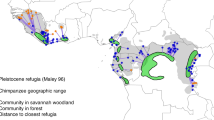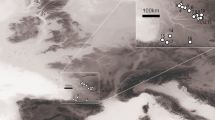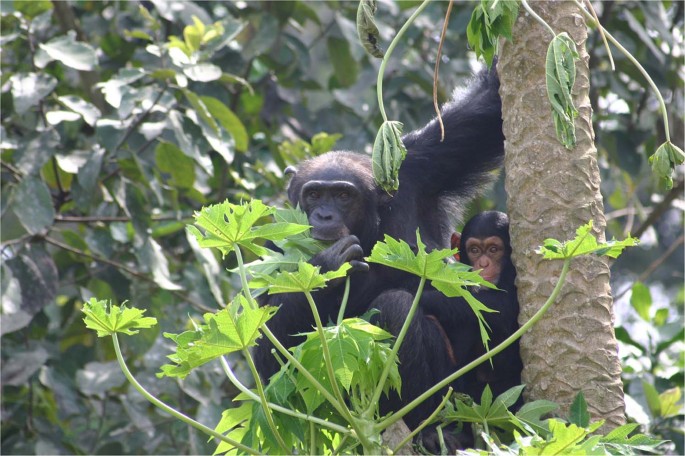
In recent decades, researchers have increasingly documented the impact of anthropogenic activities on wild animals, particularly in relation to changes in behaviour. However, whether human-induced behavioural changes in wildlife may be considered evidence of cultural evolution remains an open question. We explored whether behavioural responses to different types of human activities in species already known to display behaviour transmitted through social learning, particularly non-human primates (NHPs), are suggestive of cultural evolution in the wild. Results indicate that human influence on NHP cultural repertoires includes the modification and disappearance of existing cultural traits, as well as the invention of novel traditions with the potential to become cultural. These examples are found mostly in the domain of food acquisition, where animals modify their diet to include new resources, and adopt novel foraging strategies to avoid humans. In summary, this paper suggests that human activities can act as a catalyst for cultural change in animals, both in terms of threatening existing traditions and fostering new ones. The current situation may echo environmental changes thought to have triggered major behavioural adaptations in our own evolutionary history and thus be useful for research on human cultural evolution. As wildlife is increasingly exposed to humans and their activities, understanding how animal behaviour patterns and cultures are impacted and change in response to anthropogenic factors is of growing conservation importance.



There has been a recent surge of interest in studying the impact of human activities on wild animal populations. Many species and/or populations cannot avoid humans and must therefore display behavioural strategies to cope with the ever-growing human disturbance in their environment (Candolin and Wong, 2012, McLennan et al., 2017, Barrett et al. 2019). This paper investigates animal, in particular non-human primate (NHP), potentially cultural responses to human activities (e.g., agriculture, hunting, road development). When these behavioural changes are deemed cultural (innovation is made by one or a limited number of individuals and is subsequently learned by others through social means (Fragaszy and Perry, 2003)), it suggests that humans can drive cultural change or cultural evolution (used synonymously; see below and Lamon et al., 2018; Mesoudi and Thornton, 2018) in other species. Our aim here is to collect behavioural adaptations to human disturbance that have possibly, or have the potential to, spread culturally in a given animal population.
Although numerous species exhibit behavioural variations in response to humans and their activities (see review in Barrett et al., 2019), our focus is on NHPs because of our joint expertise, but also because NHPs fulfil an unusual conglomerate of factors relevant to this question: (1) many NHP species are large-bodied and slow reproducing, long-lived species (Charnov and Berrigan, 1993, van Schaik et al., 2006) for which behavioural flexibility is the main (if not the only) way to respond quickly to environmental changes; (2) there is an extensive literature on NHP social learning and culture in both captive and wild settings, with some records spanning over 50 years on the same populations (Whiten et al., 1999, Kawai, 1965, Hirata et al., 2001), and with growing evidence that wild NHPs need to learn their skills during development through socially aided learning (Schuppli et al., 2016, Lamon et al., 2017); (3) NHPs provide the opportunity to discuss possible drivers of human cultural evolution through homology (Whiten et al., 2010). Nevertheless, there are also many examples of non-primate cultures that are impacted by humans and are possibly subject to cultural evolution (Brakes et al., 2019). Rather than an exhaustive catalogue of possible animal cultural behaviours that might be impacted by humans, this piece provides a theoretical framework for understanding how humans may impact non-human cultures, and calls for conservation strategies to take account of behavioural diversity to ensure that ‘cultural units’ (i.e., identifiable patterns of behaviour that have a socially learnt origin) are preserved (Whitehead, 2010, Greggor et al., 2014).
Some species cope with human disturbance through genetic adaptation (e.g., Marnocha et al., 2011). However, for species with slow life histories genetic adaptation is difficult to achieve over short time periods. Another strategy in response to locally changing conditions (e.g., anthropogenic food sources, McLennan and Hockings, 2014) is proximately induced behavioural flexibility (Sih et al., 2011), that is “behavioural responses to changing local conditions, reflecting solutions to ecological or social problems” (p215, Hockings et al., 2015a). A prime example of behavioural flexibility in animals is the documented adaptation to ongoing human-provoked climate change (Beever et al., 2017). If such climate-change-led adaptations fit the cultural criteria, this will constitute strong evidence that humans alter animal cultures indirectly. However, because there is currently limited evidence of the connection between climate change and animal cultures (but see Wild et al. (2019) who report that culture may alleviate the effects of climate variation in bottlenose dolphins (Tursiops aduncus)) and specifically NHP cultures, our focus will be on behavioural adaptations in response to direct encounters with humans or human activities. Habitat loss and fragmentation have been shown to reduce movements in numerous mammal species worldwide (Tucker et al., 2018), with many mammals (e.g., elephants, (Loxodonta africana, Bates et al., 2007)) or chimpanzees (Pan troglodytes, Hicks et al., 2013)) modifying their behaviour to avoid contact with humans. However, avoidance behaviour can be the result of a variety of processes (e.g., predator or threat avoidance, neophobia), which are not specifically connected to human activity or necessarily learned. An example of direct avoidance of humans is the development of nocturnal crop-foraging behaviour in one community of chimpanzees at Sebitoli in Uganda (Krief et al., 2014). Such behavioural responses, far from being isolated (see review in McLennan et al., 2017 and Table 1), suggest that novel behaviours in wild NHPs and other species may enter their behavioural repertoire as a result of human activities. However, it is important to determine whether these behavioural modifications are cultural.

Table 1 provides examples of current behavioural changes in NHPs, which were induced by anthropogenic activities and likely to be cultural or to become cultural in the near future. To qualify for inclusion examples had to fulfil two criteria: there had to be evidence that (i) the trait belonged to the cultural repertoire of the species in the wild (i.e., being socially transmitted, ideally between age classes, or demonstrating longevity beyond the founder(s), although for some examples such requirement may not be fulfilled because of the recent appearance of the behaviour) and, (ii) that the observed change is attributable to human influence. For some of our examples (those denoted with an ‘a’ in Table 1), there is no direct connection between the evidence for social learning presented on the one hand, and the behavioural adaptation to human influence on the other, meaning these examples are relatively speculative. However, these examples were included in consideration of the fact that if no action is taken to study how animal cultures are influenced by human activities, populations exhibiting these potential cultural adaptations may well have disappeared by the time they are considered cultural (e.g., Sapolsky and Share, 2004). Indeed, clear unequivocal evidence that behavioural variants belong to the cultural repertoire of a species are notoriously difficult to obtain (Hobaiter et al., 2014, Allen et al., 2013, Hirata et al., 2001). The goal here is to identify behavioural adaptations that have the potential to be cultural responses to human activities and to spur further debate and research regarding the topic.
The examples in Table 1 can be linked to three major types of human influence, as they can be a reaction to: first, the mere presence of humans in the environment; second, the introduction of novel substrate by humans; and third, the human destruction of the environment (variously resulting in perturbational or relocationary NC due to opportunity or necessity). In agreement with previous analyses of innovation behaviour in NHPs (Reader and Laland, 2002), the majority (69%) of our recorded cases (9 of 13 cases) concern behavioural changes in the foraging domain. Of the 16 behavioural adaptations recorded within these 13 cases, 25.0% (4 of 16) represent a decrease or loss of behaviour (e.g., a decrease in stone tool use in long-tailed macaques, Gumert et al., 2013), 37.5% (6 of 16) represent a modification to an existing behaviour (e.g., chimpanzee nest manufacture using introduced plant species, McCarthy et al., 2017), and 37.5% (6 of 16) a novel behaviour (e.g., development of fish eating in Japanese macaques, Watanabe, 1989).
The low number of cases so far may be due to the difficulty with which wild animal cultural traits are identified (Kendal et al., 2010b). The drawbacks of the exclusion method are known (Laland and Janik, 2006): it can be hard to gather data from enough groups to ascertain that a given variant is truly cultural; and social learning may be involved in the spread of a behaviour pattern even where its distribution is also influenced by ecology. A prime example of this type-II error is found in variations in diet, which may be both driven by ecology but also culture (Jaeggi et al., 2010). This is important as the inclusion of human-introduced trees or crops into the diet (McLennan and Hockings, 2014) are likely to constitute a major part of NHP behavioural responses to humans. Despite its known flaws, the exclusion method allows the identification of potential cultural traits by a simple and comparative ethological approach (Laland et al., 2009). In addition, alternative statistical methods that directly assess the presence of social learning in the transmission of a trait can be used when possible (Farine et al., 2015, Kendal et al., 2010b). Nevertheless, their application to non-intentional/non-experimental human-induced environmental change (e.g., Hobaiter et al., 2014) relies on serendipitously observing a population undergoing change. Here, paying closer attention to the responses of non-human animals to human induced change, especially those from long-term research sites, will provide the opportunity to gather the information necessary to infer evidence for cultural change (Box 1). Finally, correlational approaches that assess both the degree to which animal populations are exposed to human disturbance and the extent by which a possible cultural repertoire has varied over time will be instrumental to determine how the type and degree of human-provoked disturbance might modify species’ cultural repertoires. Such approaches, however, necessitate knowledge of the extent of a given population’s repertoire, which can often take several decades (Boesch and Boesch-Achermann, 2000). Therefore, this approach will be limited to the small (but growing) number of well-documented populations in NHPs and other species.
Type of disturbance